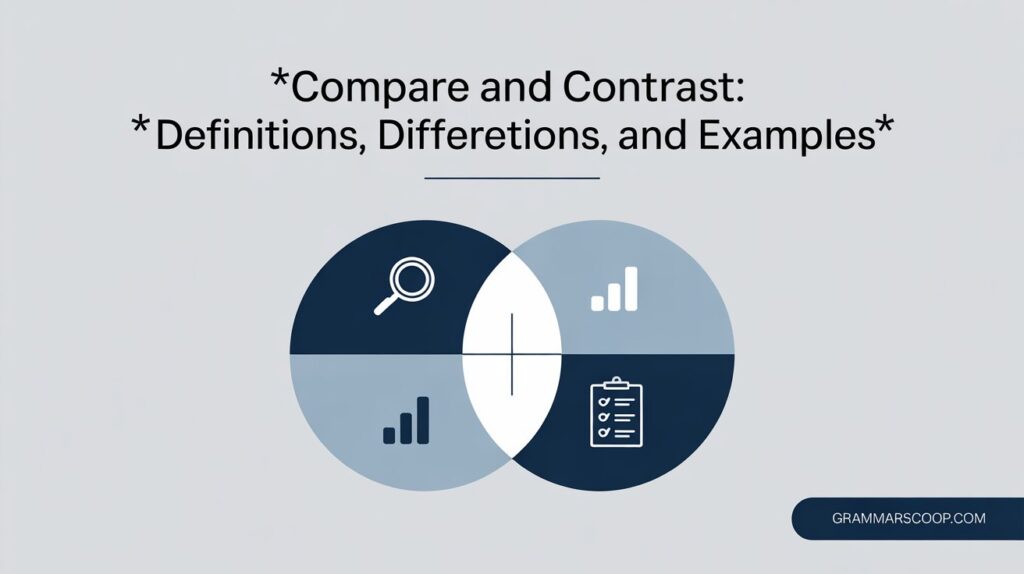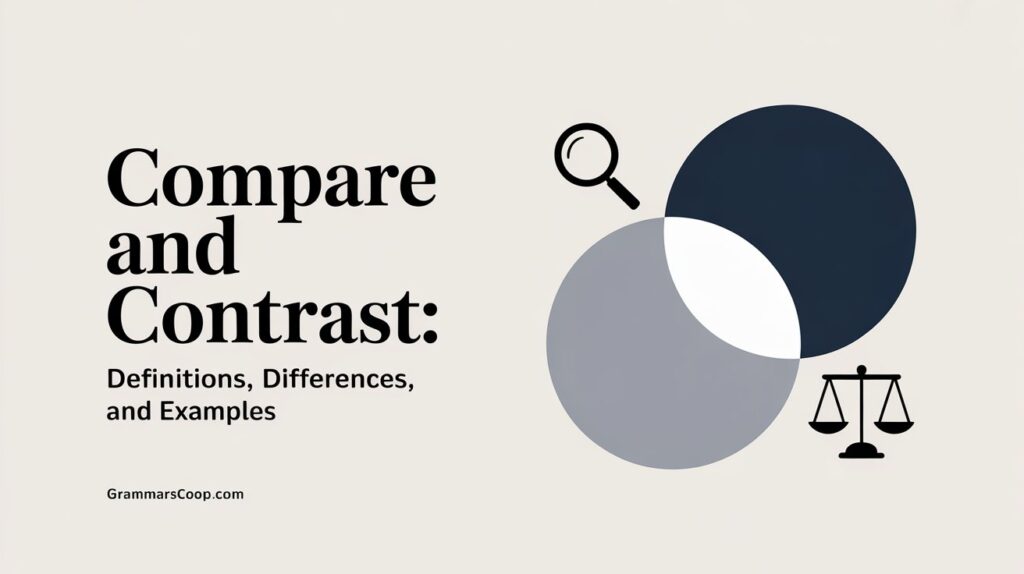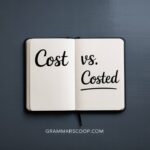Language gives us the power to think clearly, express ideas, and make smart decisions. One of the most essential skills in both writing and communication is the ability to compare and contrast. Whether you’re analyzing two books, choosing between job offers, or evaluating new tech gadgets, knowing how to compare vs contrast helps you uncover deeper insights.
In this guide, we’ll break down what compare and contrast really mean, explain how they differ, provide practical examples, and explore their real-world use. From definitions and synonyms to structure and writing strategies—you’ll learn how to use both effectively, whether in essays or everyday conversations.
Quick Summary
- Compare: Highlights similarities between items.
- Contrast: Highlights differences between items.
- Compare and contrast: Involves doing both for deeper understanding.
Compare and contrast meaning: Analyzing two or more things to understand what they have in common and how they differ.
What Does “Compare” Mean?

To compare means to observe and point out what two or more items share. It’s about finding similarities—either obvious or subtle.
Examples:
- Comparing smartphones based on battery life and camera quality.
- Comparing authors’ writing styles in different novels.
- Comparing universities by tuition cost and reputation.
“When you compare things, you align them to highlight common ground.”
Academic usage: Teachers often ask students to compare historical events, theories, or characters to deepen critical thinking.
Compare in a sentence:
“The article compares renewable energy sources based on cost, efficiency, and environmental impact.”
What Does “Contrast” Mean?
To contrast means to spotlight how things are different—sometimes dramatically, sometimes subtly.
Examples:
- Contrasting fiction and nonfiction writing styles.
- Contrasting city vs rural life in terms of pace and lifestyle.
- Contrasting political ideologies to show core differences.
“To contrast is to stand things against each other to expose what makes them unique.”
Academic usage: Used in essays, debates, and arguments to show differentiation.
Contrast in a sentence:

“The author contrasts the chaotic nature of war with the serenity of peace.”
Compare vs Contrast: The Key Differences
Though often used together, compare and contrast have different objectives and methods.
Purpose
| Function | Compare | Contrast |
|---|---|---|
| Goal | Find similarities | Show differences |
| Why | To show connections or likeness | To highlight unique features |
| Result | Builds understanding of common traits | Clarifies how items diverge |
Focus
- Compare = What’s the same
- Contrast = What’s different
Example:
Compare: “Both the iPhone and Galaxy have high-resolution cameras.”
Contrast: “The iPhone emphasizes design, while the Galaxy prioritizes customization.”
Method
There are three popular formats in writing:
- Venn Diagrams – Great for visual comparisons
- Point-by-Point – Discuss one aspect at a time
- Block Format – Cover all aspects of one item, then the other
Each format helps organize thoughts clearly for your audience.
Compare and Contrast Definition in Context
Let’s explore how these words function in real-world writing and speech.
Compare: In context
- “The report compares salaries in tech versus healthcare industries.”
- “She compared last year’s marketing campaign with this year’s to track performance.”
Contrast: In context
- “The movie contrasts love and loneliness through powerful visuals.”
- “He contrasted the leadership styles of two CEOs.”
Knowing what does compare and contrast mean gives you a better grip on communicating ideas with nuance and clarity.
Synonyms of Compare and Contrast
Avoid repetition and sharpen your writing with these alternative terms.
Compare Synonyms:
- Evaluate
- Correlate
- Match
- Analyze
- Measure
| Word | Best Use |
|---|---|
| Correlate | Data-driven analysis |
| Evaluate | Product reviews, decision-making |
| Analyze | Academic or technical comparison |
Contrast Synonyms:
- Distinguish
- Oppose
- Set apart
- Diverge
- Differentiate
| Word | Best Use |
|---|---|
| Oppose | Political or debate writing |
| Set apart | Branding, product descriptions |
| Differentiate | Marketing, education, training |
Explore further:
- Preexisting or Pre-Existing: Which One is Correct?
- What is Plural of Fox and What is Plural of Ox?
- Skill Set Or Skillset And Skill-Set: Which Is Actually Correct?
- Agreeance vs Agreement: Which One to Use?
- What’s the Plural of Iris? Explanation with Examples
Origins of Compare and Contrast
Words carry stories. Here’s a peek at where compare and contrast come from.
Origin of “Compare”
- From Latin comparare, meaning “to pair” or “to bring together”
- First recorded in English in the 14th century
- Initially used in philosophy and logic
Origin of “Contrast”
- From Latin contra (against) + stare (to stand)
- Came into English in the 16th century
- First used in art and literature to describe juxtaposition
Compare and Contrast in Writing and Critical Thinking
This technique shows up everywhere—from essays to ad campaigns. It helps you evaluate ideas, explain differences, and make informed decisions.
In Writing
- Essay prompts: Compare and contrast two characters, ideologies, or periods in history
- Literature: Compare writing styles; contrast themes or settings
- Argumentative essays: Highlight differences in viewpoints
In Thinking
- Breaks down complex ideas
- Encourages objective evaluation
- Builds persuasive power
“Compare and contrast is the backbone of critical thinking.”
Compare vs Contrast Summary Table
| Element | Compare | Contrast |
|---|---|---|
| Meaning | Show similarities | Show differences |
| Purpose | Reveal likeness | Emphasize distinction |
| Common Uses | Reviews, product analysis | Editorials, opinion pieces |
| Writing Styles | Block, point-by-point | Juxtaposition, structured essays |
| Reader’s Benefit | Understand connections | Understand divergence |
Using Compare and Contrast in Real Life
This method isn’t just for English class—it’s practical, too.
Tech
- Compare laptops based on speed and storage
- Contrast Mac vs Windows user experience
Business
- Compare vendors for pricing and support
- Contrast marketing strategies
In Education
- Compare theories or methods
- Contrast scientific models
Healthcare
- Compare treatment plans
- Contrast side effects of medications
What Does Compare and Contrast Mean in Real Life?
In real-life decision-making, this method is essential.
- Choosing a car? Compare safety ratings, contrast fuel efficiency.
- Picking between colleges? Compare cost and courses, contrast location and culture.
- Job offers? Compare salaries, contrast company values.
Using the compare Vs contrast definition practically allows for smarter, more confident choices.
Conclusion: Why Compare and Contrast Matters
Knowing how to compare vs contrast makes you a sharper thinker, a better communicator, and a more persuasive writer.
- Compare = Similarities
- Contrast = Differences
- Compare and contrast = A complete understanding
This method clarifies confusion, deepens understanding, and strengthens arguments.
Final Thoughts:
Use this skill to assess situations, organize thoughts, and communicate clearly. From everyday decisions to academic essays, knowing what does compare and contrast mean is a valuable asset.
“To compare is to connect. To contrast is to clarify. To do both is to understand.”
Recap Table
| Keyword | Explanation |
|---|---|
| Compare and contrast | Evaluate items for both similarities and differences |
| Compare vs contrast | Focus on either likeness (compare) or difference (contrast) |
| Compare and contrast meaning | Analytical method for deeper understanding |
| Compare and contrast definition | A way to break down and examine relationships between subjects |
| What does compare and contrast mean | It means to use logic and structure to explore ideas fully |

Lisa Morris is a seasoned blogger and language enthusiast with a passion for making grammar simple and engaging. At Grammar Scoop, she shares clear, concise tips that help readers master the rules of English with confidence.






